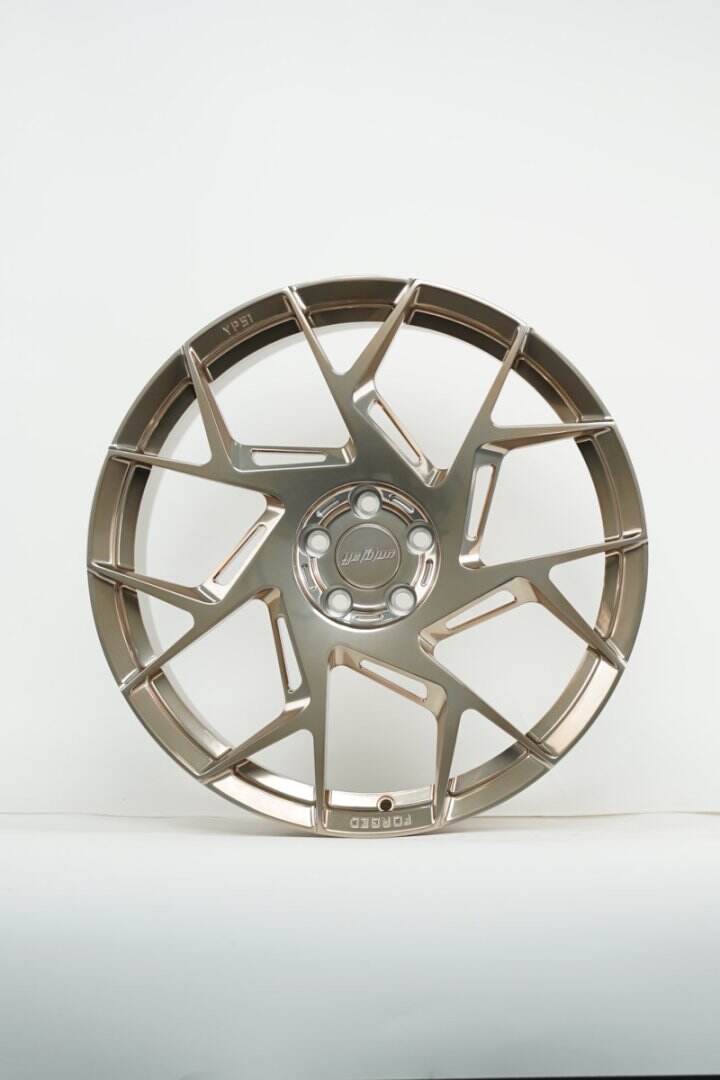How Racing Wheel Design Impacts Lap Times
Weight Reduction & Rotational Mass Efficiency
Lighter racing wheels make a big difference in lap times because they help cars accelerate faster and stop quicker. When wheels are not so heavy, vehicles react better when speeds change, meaning less energy gets used up just getting going or slowing down. Rotational mass is another factor here basically talking about how much effort goes into spinning those wheels around. The heavier this mass, the harder the car has to work to perform well. Real world testing backs this up too. Some track data from actual races shows that cutting wheel weight by about 20 percent can shave off roughly 0.2 seconds per kilometer on lap times. That might not sound like much, but in competitive racing every fraction counts.
3-Piece Wheels & Modular Construction Advantages
Three piece wheels with their modular design let racers customize setups for all sorts of track conditions, which really boosts performance on the circuit. Built from three main parts outer rim, inner rim and center section these wheels can be tweaked precisely for whatever race situation comes up. There are several good reasons why this modular approach works so well. For starters, when something breaks during practice or qualifying, teams can just swap out the damaged component instead of replacing the whole wheel. Plus, the flexibility means crews can switch between different configurations depending on whether they're facing rain slicks or dry pavement. Take Team Apex for instance they switched to three piece wheels last season and saw noticeable improvements in cornering speed and responsiveness through technical sections. The ability to adjust quickly to changing conditions gives teams a real advantage, especially when track temps fluctuate or unexpected weather hits mid-race.
Material Innovation in Performance Wheel Rims
Forged Aluminum Alloys: Strength-to-Weight Ratio
Forged aluminum gives a real edge compared to regular cast aluminum when it comes to strength and how well it bends without breaking. On race tracks where wheels face constant punishment from rough pavement and heavy loads, this matters a lot because forged rims hold up much better under all that stress. The way forged aluminum packs so much strength into lighter weight makes cars go faster and stop quicker something every racer wants. Material scientists have tested this stuff extensively and found that forged aluminum parts don't warp or crack even when pushed to their limits. That's why most serious racers stick with forged wheels despite the higher price tag.
Carbon Fiber vs. Magnesium: Durability Trade-offs
Looking at carbon fiber versus magnesium for racing wheels involves considering weight, strength, and how long they last. Carbon fiber stands out because it's super light yet incredibly strong, which explains why so many racers go for it. Magnesium isn't far behind when it comes to weight either, plus it handles heat really well. But what really matters is how these materials hold up during actual races when things get rough. Track data shows carbon fiber wheels generally last longer and perform more consistently than magnesium ones, even when pushed hard through corners or over rough pavement. While magnesium has its advantages, most teams still prefer carbon fiber for its toughness, even though it might not always stand up to impacts quite as well as some would hope.
Wheel Offset Dynamics and Track Performance
Understanding Rim Offset for Optimal Vehicle Fitment
The rim offset plays a big role in how well a car fits and performs on race tracks. Basically, it measures the space between where the wheel mounts and the middle line of the rim, which determines where the wheel actually sits compared to the fenders and suspension parts. When racers talk about offsets, they're really talking about something that makes a real difference in how stable and responsive their cars feel during competition. Racing teams have seen this firsthand through countless track tests over the years. Take positive offset wheels for example those with the mounting point closer to the outer edge these generally make vehicles respond faster and handle corners better. On the flip side, negative offset wheels stick out more from the chassis, creating wider tracks that boost grip but might put extra strain on suspension bits over time. Most mechanics will tell anyone serious about racing that picking the right offset isn't just important it's absolutely necessary if drivers want both good stability and sharp handling. Typical numbers run anywhere from +40mm all the way down to -20mm, and each choice brings different benefits based on what kind of racing conditions someone expects to face.
Alignment Effects on Cornering Stability
Getting wheel alignment right makes all the difference when it comes to cornering stability in racing cars. When everything lines up properly, each wheel maintains good contact with the track surface during turns. The position of the wheel relative to the hub (what racers call offset) really matters here because it affects important settings such as camber angle and toe-in measurements. Racing teams spend hours fine tuning these alignments based on their particular wheel offsets since getting this right boosts cornering speeds and improves how the car handles around bends. Motorsport engineers have seen time and again that small tweaks to alignment settings, especially those related to wheel offset, make corners feel much more stable. Drivers can push harder through turns without losing control. And remember, even minor mistakes in alignment mean less grip and faster tire wear, which nobody wants in competition where every second counts.
Thermal Management Strategies for Racing Wheels
Heat Dissipation in High-Speed Scenarios
Managing heat effectively makes all the difference when it comes to how racing wheels perform, particularly during those intense high speed moments. These wheels face serious heat buildup from quick bursts of acceleration, constant friction against the track surface, and repeated hard braking throughout a race. This kind of heat really matters because it affects both how fast drivers can complete laps and ultimately determines who wins the race. Most racing teams now focus on heat dissipation tech as part of their strategy. Some use lighter materials that conduct heat better while others coat their wheels with special treatments that resist overheating. Look at professional circuits where this matters most - Formula One events like the Chinese Grand Prix come to mind. There, teams that get heat management right consistently see better lap times and maintain vehicle stability even when pushed to their limits on track.
Brake Cooling Integration with Wheel Design
When engineers build brake cooling systems right into wheel designs, they're actually giving race cars a real performance boost. The tricky part? Making sure these wheels still hold up structurally and don't mess with how air flows around them. We've seen some interesting developments lately, like those fancy ventilated rims and materials that conduct heat away from brakes much better than standard stuff. What makes these new wheel designs so good is that they keep brakes cooler while at the same time making cars handle corners better and drive more predictably overall. Motorsport engineers have been looking at this stuff for years now, and what they find pretty consistently points to one thing: better cooling means better results on track. Take Formula 1 for instance, where teams spend fortunes on wheel tech because keeping brakes cool matters a lot when pushing through tight corners at speeds over 200 mph. These kinds of integrated cooling systems mean brake pads last longer too, which gives drivers that extra edge when it really counts in races.
Aerodynamic Advancements in Modern Racing Wheels
Tesla Rim Innovations: Efficiency Lessons for Motorsport
The way Tesla approaches rim design is changing what people expect from efficiency and how cars cut through the air, something that really catches the attention of those working on motorsport wheels. What makes these rims stand out? They're built light but tough, with smooth curves that slice through wind resistance without compromising durability. When cars roll on these special wheels, they face less drag, which means better gas mileage and faster acceleration too. Car engineers who've tested them report that Tesla rims beat regular racing wheels hands down in terms of efficiency, giving track designers fresh ideas about how to build wheels that actually work better on the road. As teams start incorporating these kinds of smart designs into their own racing wheels, expect to see major changes across the motorsport world, where vehicles will run cleaner while still maintaining that winning edge.
Turbine-Style Designs & Drag Reduction Techniques
Turbine style wheels are becoming increasingly popular among racers because they cut down on drag during high speed runs. What makes these wheels special? They have those distinctive spiral shapes that actually help air flow better around the tires, which means less resistance and faster speeds. When it comes to how well a car performs, good aerodynamics matters a lot. Wheels with lower drag numbers tend to make cars go quicker and handle better on the track. Looking at real world results from major races shows this works too many teams now run turbine wheels specifically for their edge in competition. The bottom line is simple enough for anyone who loves fast cars to grasp: smarter wheel design equals better performance on race day.




